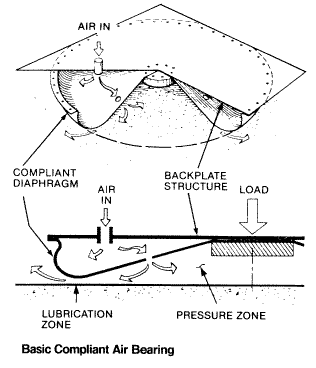Pneumatic Powered Load Moving Systems - Air Bearing
Principle

For the past thirty years, industry
has found it can move heavy, cumbersome equipment and gear easier and
faster on frictionless air. Air bearings are housed in strong
aluminum or steel caster modules, which are usually linked to other modules
to form an air bearing system that is capable of moving loads of 100
tons and beyond.
An air bearing is a simple piece of equipment that
inflates to form an air cushion, or film of air beneath it - similar
to a hovercraft - which then allows the air bearing to float on the
air and subsequently move anything that may be loaded on it. Air
bearings are generally used in multiples of at least 3 which can be
strategically placed to provide more stability to all types of loads.
Principle of Operation
 Hovair Air Bearings
are efficient movers of heavy loads. Hovair Air Bearings
are efficient movers of heavy loads.
Moving on air is the most efficient method of materials handling
on the market today. Moving heavy loads on air is a clean, quiet
and safe method which will not damage floors. One (1) pound of
force will move 1000 pounds, and one individual can move several
tons with complete control.
Precise Positioning Of Equipment
Hovair Systems enable you to move and position equipment to an
exact location. It is omnidirectional for conveniently aligning
the load to a designated area in a limited space. Positive control
of the air allows the operator to move the equipment easily and
without damage. The low profile of our systems requires less than a
3-inch clearance - even as low as 1½ inches.
The Three Stages of Inflation
Looking at the diagram below, you can see the three
stages of how a typical A-type air bearing is energized to enable it to
cause flotation of a load.
Deflated - Left: In the deflated stage, the air
bearing, housed in its caster module, is resting on the floor with most
of the weight being supported by the center load pad.
Inflated Air Bearing - Center:
The center image shows the air bearing in an inflated form after it has
formed a seal with the floor surface. At this stage, the load has not
been engaged. Load Lifted On Air
- Right: The image to the right shows the air
bearing after it has engaged and floated the load. After it has formed a
seal with the floor surface, more air is introduced into the air bearing
causing it to inflate further. Compressed air will then start to escape
from the bearing diaphragm into the area that is being contained by the
floor seal. The weight of the load causes the compressed air escaping
out of the air bearing to force downward onto the floor surface thus
causing the load to float away from the floor.

Return to All About Air Bearings
index
|